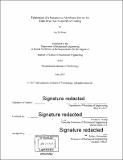| dc.contributor.advisor | Evelyn N. Wang. | en_US |
| dc.contributor.author | Sircar, Jay D | en_US |
| dc.contributor.other | Massachusetts Institute of Technology. Department of Mechanical Engineering. | en_US |
| dc.date.accessioned | 2017-10-18T15:10:32Z | |
| dc.date.available | 2017-10-18T15:10:32Z | |
| dc.date.copyright | 2017 | en_US |
| dc.date.issued | 2017 | en_US |
| dc.identifier.uri | http://hdl.handle.net/1721.1/111931 | |
| dc.description | Thesis: S.M., Massachusetts Institute of Technology, Department of Mechanical Engineering, 2017. | en_US |
| dc.description | Cataloged from PDF version of thesis. | en_US |
| dc.description | Includes bibliographical references (pages 60-63). | en_US |
| dc.description.abstract | We investigated the experimental performance of a nanoporous membrane for ultra-high heat flux dissipation from high performance integrated circuits. The biporous evaporation device utilizes thermally-connected, mechanically-supported, high capillarity membranes that maximize thin film evaporation and high permeability liquid supply channels that allow for lower viscous pressure losses. The 600 nm thick membrane was fabricated on a silicon on insulator (SOI) wafer, fusion-bonded to a separate wafer with larger liquid channels. Spreading effects and overall device performance arising from non-uniform heating and evaporation of methanol was captured experimentally. Heat fluxes up to 412 W/cm2, over an area of O.4x 5 mm, and with a temperature rise of 24.1 K from the heated substrate to ambient vapor, were obtained. These results are in good agreement with a high-fidelity, coupled fluid convection and solid conduction compact model, which was necessitated by computational feasibility, which incorporates non-equilibrium and sub-continuum effects at the liquid-vapor interface. This work provides a proof-of-concept demonstration of our biporous evaporation device. Simulations from the validated model, at optimized operating conditions and with improved working fluids, predict heat dissipation in excess of 1 kW/cm2 with a device temperature rise below 30 K, for this scalable cooling approach. | en_US |
| dc.description.statementofresponsibility | by Jay D. Sircar. | en_US |
| dc.format.extent | vi, 63 pages | en_US |
| dc.language.iso | eng | en_US |
| dc.publisher | Massachusetts Institute of Technology | en_US |
| dc.rights | MIT theses are protected by copyright. They may be viewed, downloaded, or printed from this source but further reproduction or distribution in any format is prohibited without written permission. | en_US |
| dc.rights.uri | http://dspace.mit.edu/handle/1721.1/7582 | en_US |
| dc.subject | Mechanical Engineering. | en_US |
| dc.title | Fabrication of a nanoporous membrane device for high heat flux evaporative cooling | en_US |
| dc.type | Thesis | en_US |
| dc.description.degree | S.M. | en_US |
| dc.contributor.department | Massachusetts Institute of Technology. Department of Mechanical Engineering | |
| dc.identifier.oclc | 1005738566 | en_US |
